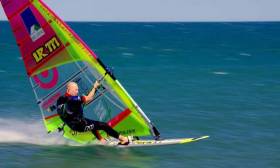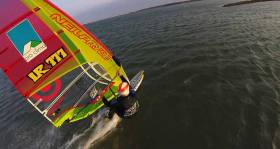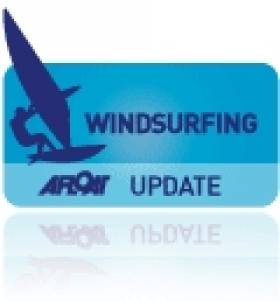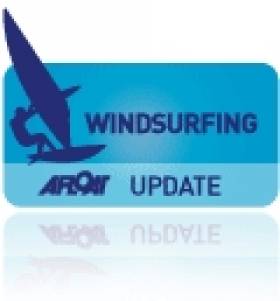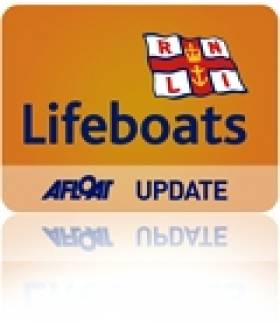Displaying items by tag: windsurfing
Oisin van Gelderen regained the Irish Speed Sailing title for windsurfing. The Dubliner achieved 44.16 knots in 77kph–winds yesterday following days of waiting for the correct conditions at the at the World Record Speed Challenge at Salin De Lapalme in Languedoc-Roussillon, France.
Van Gelderen's time has yet to be ratified by the World Speed Sailinng Record Council (WSSR) but he broke the late John Kenny's long standing record of 40.44 three times in the ideal conditions yesterday afternoon.
Windsurfer Oisín van Gelderen In Bid to Break World Speed Record
Multiple Irish Windsurfing Champion Oisín van Gelderen from Dublin joins the fastest windsurfers in the world, in a bid to break the Windsurfing Speed World Record, at a newly designed speed course at Salins De La Palme, in the south of France. The Irish GPS Speed Record Holder qualified for a wildcard invitation to the event, based on his previous speeds and potential to perform. Being invited to join the fastest windsurfers in the world at a specialised location, is the equivalent of being invited to play in the Croke Park Final, or the Golf Masters. He aims to use the opportunity to break his own personal best speeds and smash the 50knot barrier (92.6kph), and set a new official Irish Speed Record over 500merres - ratified by the WSSRC (World Sailing Speed Records Council).
The current windsurfing Speed World Record, held by Frenchman Antoine Albeau (France), stands at 53.27 knots (98.65kph) over 500 metres, which was set at purpose built speed canal in Luderitz, Namibia. This country is currently home to all the fastest speeds in the World - in both Windsurfing and Kitesurfing - and the Outright Sailing Speed World Record by Australian Sailor Paul Larsen (Aus), who in a custom build carbon fibre boat, blew everyone else away with a speed of 65.45 knots (121.21kph).
The La Palme course in France, is the brainchild of UK windsurfer Erik Beale, who in 1988 became the first sailor (of any kind) in history to break 40–knot barrier. With his vast experience, he sourced out potential locations that could provide world record breaking conditions, and found a location in France that could provide the essential combination of gale force wind and very flat water. The Tramontana wind howls offshore throughout this part of France, and the course itself is set in a salt marsh just inland of the Mediterranean, close to Leucate.
The world record challenge runs for seven weeks until the end of April, and Oisín's bid lasts for the first three weeks. To date, he has experienced moderate wind conditions for the start of the challenge, which has given good training runs but nothing near a record. For now, all the windsurfers wait for the Tramontana to properly show it's full force, and then the hope is that records will fall
Australian Windsurfer Tackles Big Waves at Nazaré, Portugal
Jason Polakow is well known for his big wave exploits - often travelling the globe to search out the biggest and best waves on the planet and he's just completed his latest mission.
With El Niño producing a colossal winter of pumping swells the Australian couldn't resist the opportunity to become the first windsurfer to sail Nazaré, Portugal, and the first footage of him doing just that is starting to emerge.
Van Gelderen Claims New Irish GPS Speed Sailing Record
#SpeedSailing - Ireland may have a new speed sailing record after Oisin van Gelderen laid claim to a 46.67-knot run at West Kirby Marine Lake in northwest England yesterday (Wednesday 28 January).
The multiple-time national champion says the WGPSSRC, the governing body for GPS speed sailing records, is currently analysing the files from his two GPS units before ratifying the new record, which he set on the man-made lake in the Wirral in winds of up to 45 knots and amid "huge squalls in hail showers".
He explained of his chosen location: "When wind direction is correct (120-135 degrees off wind) we can sail extremely close to the wall of the lake to get flattest water, uninterrupted by the strength of the wind.
"Yesterday was one of those days, though the wind turned out a little too broad, making the water too choppy and ultimately slowing us down as there was not enough space to do longer runs, meaning crashing was a huge possibility."
Van Gelderen says one fellow speedster was hospitalised with suspected concussion and whiplash from crashing "into the water - not the wall".
The potential new record, representing van Gelderen's average speed over 10 seconds, beats his previous record of 45.02. He also says he upped his average of five fastest 10-second runs to 44.97 knots, and peaked at 47.3 knots. Details of his session are available HERE.
At time of writing, the record would put him fourth in the world for GPS speed sessions in 2015 - though the table is subject to change at any time as windsurfers from around the world contribute their data.
Van Gelderen also points out that the Irish record set by his late friend John Kenny and sanctioned by the WSSRC still stands.
But the Skerries windsurfer isn't resting on his laurels, aiming for an even stronger run at Bunbeg in Donegal, where he sailed last week.
"It has huge potential [for me] to go much faster," he says. "Fifty knots is in my sights."
Bunbeg GPS Speedsailing 11-1-15. Fast Course from IR 777 on Vimeo.
Round Cobh Windsurf Race Returns In 2014
#Windsurfing - The Round Cobh Windsurf Race will make its return this summer as part of SailCork's 40th anniversary festivities.
The revival of the famous Cork Harbour windsurfing race is listed in the provisional birthday programme for the sail training business, a winner in our recent Maritime Web Awards.
Events lined up so far run from the Royal Cork Yacht Club Dinner on Saturday 8 March to the cruise to Cork City on 8 October.
For more on SailCork's summer plans visit their website HERE.
Galway Windsurfers Set Paddle Board Record
#Surfing - A trio of Galway windsurfers completed the 95km round trip to and from the Aran Islands last weekend - setting a new Irish record for stand-up paddle boarding in the process.
The Irish Times reports on the successful adventure by Dan Gardner, Daniel King and Joe Gallagher, who embarked on the challenge to raise funds for the Galway RNLI lifeboat service.
Setting out before 5.30am on the morning of Saturday 8 June, they returned to the Galway Docks before 11pm that night - stopping at the halfway mark for lunch on Inis Mór.
The trio are each believed to have covered some 4,000 strokes an hour to make their record time of 17 hours 33 minutes. The Irish Times has more on the story HERE.
In other surfing news, the Sunday Independent reports on a website that's seeking to connect surfers of all levels with the right waves for them.
Waterford-based Liam Sinnott set up Swellseekers.ie with business partner James Hassey two years ago, filling a gap in the market for booking surfing trips online at a time when Ireland was only just emerging as a world-class surfing destination.
Though the site currently only takes bookings for surfing and other watersports in the Waterford area, Sinnott says he hopes to expand his site's scope nationwide by next year to serve a growing wave-riding community of "50,000 surfing all year round".
RNLI Crews Assist Windsurfer, Stricken Fishing Boat in Co Down
#RNLI - Portaferry RNLI rescued a windsurfer who got into difficulty off the Co Down coast yesterday (16 April).
The volunteer crew launched their inshore lifeboat before 5pm yesterday evening to go the aid of the injured windsurfer reported to be in the area of Pig Island, a small island in Strangford Lough close to Newtownards Sailing Club.
The weather at the time was described as blowing slight to moderate winds with good visibility.
The crew was on scene at 5.15pm where they found the man on Pig Island accompanied by two other men. The windsurfer, who was suffering from a shoulder injury, was transferred to the lifeboat and made comfortable before being taken to the sailing club, where he was then transferred into the care of the coastguard and passed to the ambulance service to be taken to hospital.
Speaking after the rescue, Portaferry RNLI lifeboat operations manager Brian Bailie said: "As the charity that saves lives at sea, we will always respond to any call for help where someone is in danger.
"Strangford Lough is a popular destination for a wide range of water sport enthusiasts and it is important that they take all necessary precautions when using the lough.
"As we are all aware, accidents can and do happen and it is at such times that the work carried out by the volunteer crews of the RNLI is so important."
Elsewhere in Co Down yesterday, Bangor and Donaghadee RNLI assisted a fisherman whose 28ft commercial fishing boat experienced engine failure.
The crew quickly located the disabled boat one mile west of the Copeland Islands at the mouth of Belfast Lough yesterday morning after 11.15am.
With the vessel drifting closer to the island shores and the wind gusting gale force eight, a tow line was quickly rigged and passed to the fishing boat. Bangor RNLI was escorted by Donaghadee RNLI's all-weather lifeboat as it towed the fishing vessel to the safety of Bangor Harbour.
Bangor RNLI volunteer helm Peter Scott, who was involved in this rescue, said: "Engine failure close to shore could lead to a life threatening situation. We always urge everyone going to sea to make sure their electrical systems and engine are well maintained and in good working order. A good anchor and chain should always be carried as part of essential safety equipment.
"We are glad the skipper of this vessel is now safely ashore," he added.
First Irish Woman To Windsurf Infamous Hawaiian Wave
#Windsurfing - History has been made in Hawaii with the first Irish woman ever to have windsurfed the infamous 'Jaws' surfing break, as The Irish Times reports.
Twenty-six-year-old Katie McAnena, a doctor from Galway, demonstrated perfect timing as she leapt into the water from an overhanging cliff.
An experienced windsurfer with four Irish women's championships to her name, McAnena told the paper how she maintained caution on the wave and stayed on its shoulder to ride it out.
“The sound and the feeling of it going through my bones was extraordinary, an out-of- body experience,” she said. “I haven’t managed to sleep since.” The Irish Times has more on the story HERE.
It's been an exciting time lately for Ireland's women waverers, as just six months ago northwest surfing scion Easkey Britton became the first woman ever to surf in the waters off Iran.
Storm Chase Mission 2 Abandoned At Last Minute
#Windsurfing - Mission 2 of the Red Bull Storm Chase to Galicia has been abandoned at the last minute due to an unstable weather forecast for the coast of northern Spain.
It's a big blow to the six waveriders who qualified for the second-stage of the global windsurfing challenge after three rounds of exciting competition in Brandon Bay less than two months ago.
The storm-force winds that swept the Kerry coast at the end of January provided the perfect conditions to test the mettle of the brave sailboarders who took to the water at the 'Dumps' ad 'Hell's Gate'.
Of the ten-strong field, six survived to advance to the second round - Marcilio Browne, Dany Bruch, Victor Fernandez, Robby Swift, Julien Taboulet and Thomas Traversa.
And Red Bull have posted a video compilation of highlights of all the action from Mission 1 in Kerry, which you can see below:
Lifeboat Rescues Windsurfer In Stormy Conditions
#RNLI - Kilkeel RNLI rescued a windsurfer who got into difficulty in Carlingford, Co Louth yesterday (Tuesday 29 January).
The charity’s volunteer lifeboat crew was requested to launch by the Irish Coast Guard shortly after 2pm following a report that a windsurfer had got into difficulty in Carlingford Lough.
Launching their inshore lifeboat immediately, the crew encountered very unfavourable weather, with strong westerly winds of between force six and seven.
The lifeboat proceeded up the lough where they found and retrieved the windsurfer who had stayed by his board. The crew then attempted to retrieve the sail and board but couldn’t due to the windy weather conditions. They instead proceeded to tow the board into Greenore where the local coastguard took over.
Despite being in the water for approximately an hour, the casualty was described as being in reasonably good health.
Roy Teggarty, Kilkeel RNLI lifeboat operations manager, paid tribute to the lifeboat crew for their efforts in what was a challenging rescue:
"This was a day with difficult conditions because of the strong winds," he said. "It was mainly difficult to keep the lifeboat steady when retrieving the casualty so this rescue involved expert boat handling by all involved."





























